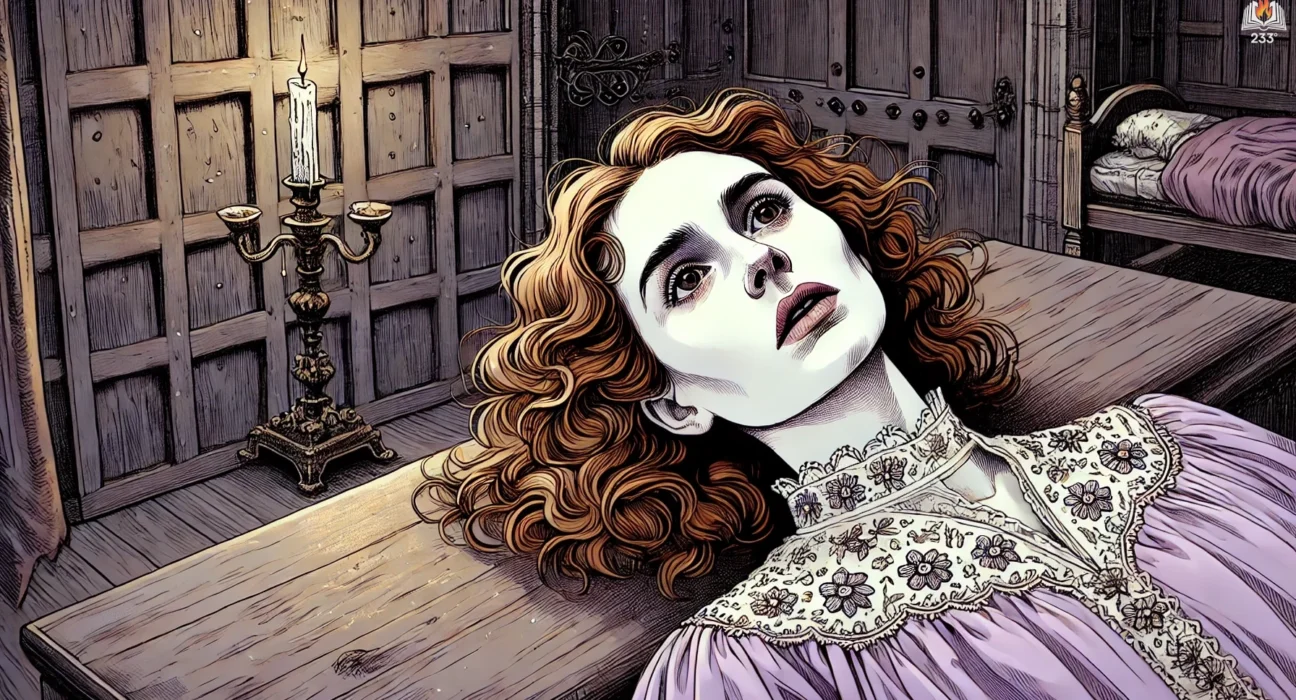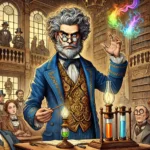“The Donnington Affair” is a detective mystery penned by Gilbert Keith Chesterton, first published in 1914. The story involves a tangled web of crime, false identities, and the astute observations of Chesterton’s famous sleuthing priest, Father Brown. Set against the backdrop of an English manor shrouded in secrecy and tragedy, the tale unfolds with the mysterious death of a young woman named Evelyn. This event sets the stage for a complex investigation, drawing in characters with conflicting motives and hidden pasts.
Plot Summary
On the edge of the sprawling English countryside, the Donnington manor sits in eerie silence, shrouded in the lingering mists of tragedy. Its ancient walls, draped in shadows, have witnessed secrets that twist and turn through time. Now, they bear witness to the latest and darkest secret of all: the mysterious death of Evelyn Donnington. Her body, found lifeless in a dressing gown near the ominous “Priest’s Room,” sets off a chain of events that will unravel the very fabric of the family and the manor itself.
Evelyn’s death is a shock to the household. Sir Borrow, the aging patriarch, is stricken with a grief that goes beyond the loss of a niece. It is the sorrow of a man who has seen too many tragedies, who has lived under the weight of secrets and scandals that have plagued the Donnington name. The room where she is found, the Priest’s Room, is a place steeped in legend and fear, known for its history of concealment and betrayal. It is said that those who enter it are either hiding from the world or hiding something within themselves.
In the midst of the confusion, a stranger appears—Mester, a man with a demeanor as rugged as his mud-stained attire. He carries the air of a wanderer, someone who has seen the world in all its dirt and glory. The household is taken aback by his brazen entrance, his peaked cap casting a shadow over eyes that seem to glimmer with unsaid truths. He whistles nonchalantly as he strolls into the room, paying little heed to the gravity of the situation. But there is something about him, a confidence that suggests he knows more than he should, that he is not just an intruder, but someone with a purpose.
It becomes clear that Mester is not who he seems. His real identity is that of Stephen Shrike, a detective of some renown, known for his unconventional methods and his ability to solve the unsolvable. He has orchestrated an elaborate scheme to uncover the truth behind Evelyn’s death, a scheme that involves deception, manipulation, and a deep understanding of the human psyche. Mester reveals that he had engineered the escape of a convict named Southby, luring him into a trap that would ultimately expose the secrets of the Donnington family.
Southby is an innocent man, drawn into this web by forces beyond his control. He receives a letter in cipher, a language known only to him and his sister, urging him to escape and meet her in a place of safety. The letter is a ruse, designed to lead him into the open, to make him believe that he is the target when, in fact, he is merely a pawn. His flight from justice is a carefully orchestrated performance, with Mester playing the roles of both the hunter and the hunted.
As Father Brown arrives on the scene, the atmosphere shifts. He is a man of quiet presence, his eyes taking in the room with a calmness that belies the tension in the air. His gaze falls on the body of Evelyn, not with the cold detachment of an investigator, but with the compassionate curiosity of a man who seeks to understand the soul behind the crime. He muses aloud, “The key might be found in the sentence that ‘Mester was the cheeriest soul possible.'” A strange observation, given the circumstances, but one that hints at the deeper layers of the mystery.
Father Brown’s investigation takes him through the labyrinthine corridors of the Donnington manor, both literal and metaphorical. He uncovers a history of lies and deceit, of relationships built on false pretenses and secrets kept out of fear. Evelyn is at the center of it all, a woman whose actions were driven by motives hidden beneath a veneer of propriety. She had been part of a conspiracy, a plot that involved the manipulation of those closest to her, including her sister, Harriet.
The separation of the sisters becomes a focal point in the unraveling mystery. Harriet had been sent to Bath under the guise of assisting in a family matter, but the true purpose was far more sinister. It was a deliberate act to isolate Evelyn, to leave her alone and vulnerable in her final moments. The revelation that Southby had been deceived into thinking his sister was in danger only adds to the tragedy of his situation. He had been willing to risk everything for her, not knowing that he was being used as a tool in a larger game.
The Priest’s Room, long shrouded in secrecy, is finally opened to reveal its true purpose. It is not just a hiding place, but a mirror that reflects the hidden sins of those who enter it. Behind its sealed door lies the answer to the mystery, a truth that has been kept in the dark for far too long. Father Brown and Mester enter the room, only to find not a ghostly apparition, but the living presence of Sir Borrow. The old man, once a symbol of stern morality and justice, has been twisted by the events surrounding Evelyn’s death. His sense of duty has become a weapon, one that he has used to strike down what he perceived as a threat to the family’s honor.
The final confrontation is not one of violence, but of revelation. Father Brown does not accuse or condemn; he simply lays out the facts, allowing the weight of the truth to fall where it may. Evelyn’s death was the result of a twisted sense of justice, a need to restore balance in a world that had gone awry. Sir Borrow, in his rigid adherence to his own moral code, had become blind to the nuances of right and wrong, leading to an act that could never be undone.
In the end, the mystery of Evelyn Donnington’s death is solved not by the law, but by the understanding of human nature. Father Brown’s role is not to punish, but to reveal, to bring to light the hidden motives and desires that drive people to commit acts of darkness. He sees the tragedy for what it is—a reflection of the complexities and contradictions of the human soul.
As the manor settles back into its silence, the mists begin to lift, but the shadows remain, a reminder that some secrets, once uncovered, can never truly be forgotten.
Main Characters
- Father Brown: A perceptive Roman Catholic priest known for his keen insight into human nature and crime. His quiet demeanor hides a sharp intellect that sees beyond the obvious.
- Mester/Stephen Shrike: Initially introduced as a convict, Mester is later revealed to be the detective Stephen Shrike. He orchestrates a complex plot to uncover the truth behind Evelyn’s death.
- Evelyn Donnington: The central figure of the mystery, Evelyn’s life and death are shrouded in secrets. Her actions and motives are gradually uncovered, revealing a complex character entangled in a web of deceit.
- Sir Borrow: The aging patriarch of the Donnington family, whose stern sense of justice and morality is twisted by the events surrounding Evelyn’s death. He is deeply affected by the tragedy that befalls his family.
Theme
- Deception and Hidden Truths: The story revolves around the uncovering of lies and the revelation of hidden motives. Every character is shrouded in a veil of secrecy, and the truth is only revealed through careful observation and deduction.
- Justice and Morality: The theme of justice is explored through the actions of Sir Borrow, who seeks to restore balance in a world he perceives as unjust. His rigid sense of morality leads to tragic consequences, questioning the nature of true justice.
- Isolation and Separation: The separation of Evelyn and Harriet serves as a pivotal point in the narrative. It symbolizes the broader theme of isolation, both physical and emotional, that pervades the story. The characters are isolated by their secrets, their guilt, and their inability to communicate openly.
- The Duality of Human Nature: The characters in “The Donnington Affair” are not easily categorized as purely good or evil. Each harbors both virtues and flaws, reflecting the complexity of human nature. Father Brown’s approach to solving the mystery involves understanding this duality and the motivations behind each character’s actions.
Writing Style and Tone
Chesterton’s writing style in “The Donnington Affair” is characterized by its intricate plotting and philosophical underpinnings. He employs a narrative technique that delves into the psychological depths of his characters, allowing readers to explore their motives and inner conflicts. His prose is both descriptive and analytical, painting vivid scenes while also dissecting the moral and ethical dimensions of the story. The tone is one of quiet suspense, with an undercurrent of reflection and insight.
The language is rich with paradoxes and wordplay, a hallmark of Chesterton’s work. He often presents seemingly contradictory statements that provoke thought and challenge the reader’s perceptions. The dialogue is sharp and often laden with deeper meanings, revealing the characters’ complexities. The narrative voice, particularly through Father Brown, is calm and measured, guiding the reader through the labyrinth of clues and revelations with a steady hand.
We hope this summary has sparked your interest and would appreciate you following Celsius 233 on social media:
There’s a treasure trove of other fascinating book summaries waiting for you. Check out our collection of stories that inspire, thrill, and provoke thought, just like this one by checking out the Book Shelf or the Library
Remember, while our summaries capture the essence, they can never replace the full experience of reading the book. If this summary intrigued you, consider diving into the complete story – buy the book and immerse yourself in the author’s original work.
If you want to request a book summary, click here.
When Saurabh is not working/watching football/reading books/traveling, you can reach him via Twitter/X, LinkedIn, or Threads
Restart reading!








